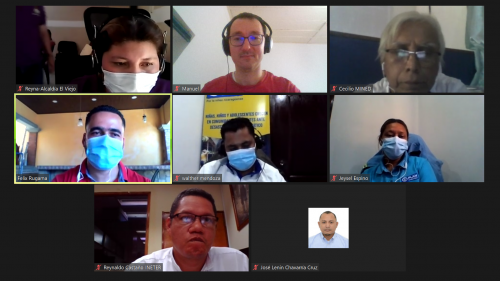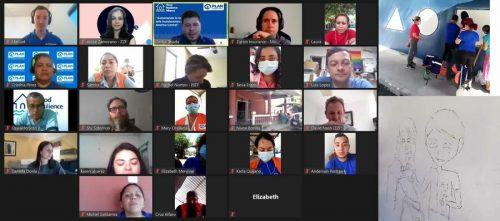By conducting and recording a virtual community visit Plan International has proven that travel restrictions in the wake of COVID-19 don’t necessarily mean we can’t visit the communities and people we work with.
“The part I miss the most is the field visits.”
David Nash, Climate Change and Partnerships Senior Manager, Z Zurich Foundation
Why did we do a virtual community visit?
In response to the COVID-19 pandemic, Plan International (Plan) put in place various measures to protect the health of our staff and the people we work with. This included travel restrictions within and between countries while shifting to (almost) completely virtual delivery across the organisation. These measures have been extended until the end of 2021.
The decision to restrict global travel and maximize remote meetings was right. After all, what is more important than the health of staff and the people we are working to impact? However, we need to be mindful of “online meeting fatigue” and be creative about how we stay connected.
I also strongly believe that as a team working with people affected by the climate crisis we should live what we preach. The global Plan team working in the Zurich Flood Resilience Alliance has therefore decided to reduce the number and increase the length of our field trips, and, where possible, combine trips per region with minimal aviation travels. Our decision was made irrespective of COVID-19 to reduce our own environmental footprint.
The field trip has shown us that not being able to travel doesn’t necessarily mean we can’t visit other places. In this video we invite you to join our visit to the communities we work with in El Salvador and Nicaragua and learn how we strengthen local communities through flood resilience building activities.
What did the virtual community visit look like?
In March 2021, over the course of one week, we organized multiple meetings internally and externally with the participation of the core project team, national stakeholders, other Alliance members, including our donor, and community representatives.
The visit provided an opportunity to report back on progress made, the challenges faced and how these are being addressed, and discuss the next steps.
Most importantly, thanks to modern technology, we were able to connect with the people at the heart of our programming, who showed us around in their communities using smartphones.
How did the participants experience the virtual visit?
From an internal, Plan International, perspective, it was great for all of us to connect “out of office” again after such a long time.
From a donor perspective managing a multi-country program, the visit provided an opportunity to connect with the people we work with and hear their stories. After all, even without the pandemic, it is nearly impossible to visit all 23+ project locations around the globe.
The feedback from community members has been overwhelmingly positive. The virtual visit allowed them to demonstrate the flood resilience building activities they are working on.

What can we recommend for future virtual community visits?
Some of the participants were not used to the technology used to facilitate the virtual visit. We would recommend providing some background information on how to properly use the devices and platforms prior to the visit, where needed. This includes seemly simple things (for those of us who have spent many months on video conference applications), like turning the camera on and off or putting yourself on mute.
Future visits should also pay more attention to putting activities into context and present a holistic narrative around individual pieces of work shown during the visit.
In general, we strongly recommend to prepare well. Don’t underestimate the time needed to plan a virtual visit. It may mean having to write up Terms of Reference and obtaining approval across various levels and multiple offices. It could also mean external visitors having to read and adhere to organizational policies.
You need to be prepared in case the internet connection fails during the visit and have presentations or videos up your sleeve in case they’re needed. Depending on the context, consider the option of simultaneous translations. We recommend the Zoom platform, as it contains a feature for simultaneous translation into multiple languages.
Additionally, think about the purpose of the visit as well as the audience you try to reach, and try to structure the format of the visit around this. We divided our visit into multiple shorter sessions to accommodate everyone’s time across multiple time zones.
Taking virtual community visits to the next level
Global travel restrictions are likely to remain in place in the short term. In the medium term, they will likely be lifted, but not unlikely to be re-installed in intervals if and when new outbreaks occur.
Even if Coronavirus related travel restrictions should no longer be an issue in the long term, we need to start changing our way of thinking about global travel and adapt our way of working, if we are serious about reducing our own environmental footprint and to ensure resilience against potential future pandemics.
The way in which we (used to) operate in the development sector needs to adapt to this new reality. A combination of remote visits on the one hand, and fewer, but targeted and extended visits in person on the other hand is an option that is worth exploring further.

We hope our approach will inspire others, but are also keen to learn how other organizations address this challenge. Do use the comment function below if you have experience to share.
Community visits in person are irreplaceable
We have adapted to the “new normal.” Recent meetings have shown that for the most part we are able to accomplish our tasks as productively as we previously did in person.
Nevertheless, it is undeniable that an essential element – the personal formal and informal touch – is missing. I think that future work will (and should) be a hybrid between remote and in person meetings. It can’t be one or the other, we need to have both.
Virtual visits are one option to go places remotely. Yet, they are not intended to replace personal encounters. Instead, they should be understood as a complementary means to stay connected with one another staying true to the objectives we set out to achieve.
Learn about Plan’s flood resilience work in Central America
Watch a short introduction to our community visits.
Join us on the full community visit.
Read about our work in El Salvador and Nicaragua.

Comments